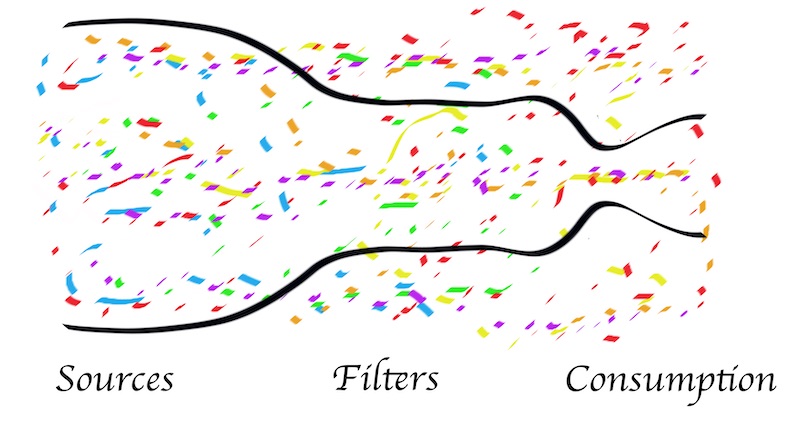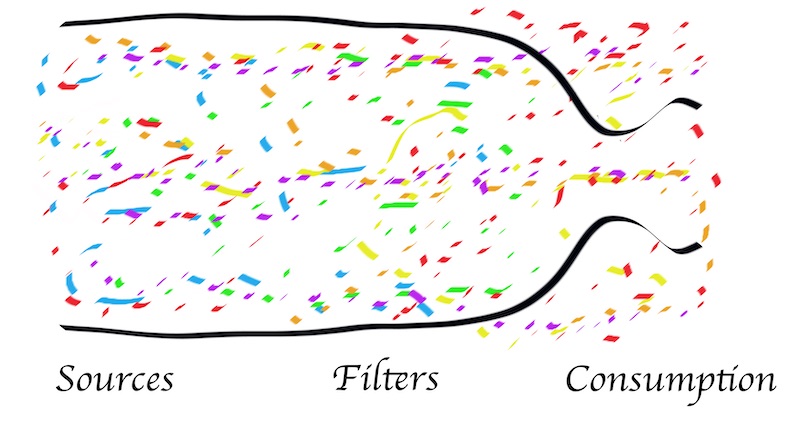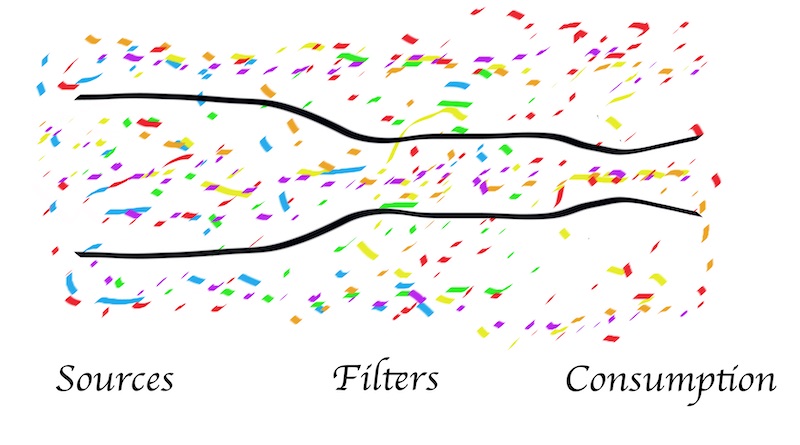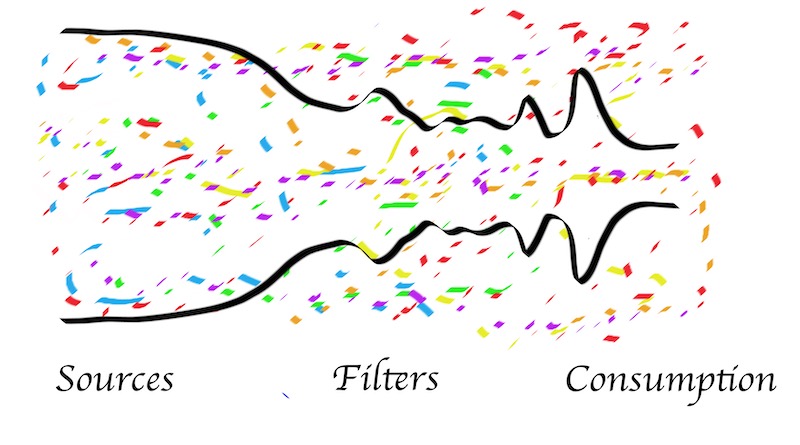How to Deal With Information Overload

My web browser is like a hydra - every time I close a tab, three more come to take its place.
There are 10 million blog posts everyday.1 Every minute, 400 hours of video content is published on Youtube. And this isn’t everything we consume - podcasts, tweets, images, pins and newsletters.
In such a world, information overload is a problem. There’s more content than what you can consume. You’ll never get to everything you want to read, see or hear.
I face this everyday. So much that I can’t deal with the 100 open Chrome tabs. This is excluding all the articles I’ve saved on Pocket to come back to. Excluding the interesting newsletters I subscribe to. Oh, did I tell you about my podcast backlog?
This looks like a problem to solve. How to deal with information overload?
Most content is absolute shite. Then there’s some mediocre content, and then there are the gems.
If I were optimising for the best content - paradigm shifting, new take on things, or just insightful - it would makes sense to look at the gems.
However, can you figure out something is a gem before reading it?
I don’t think so. The best we can do is to use proxies. Things that signal gems.
Further, you’re not always looking for gems. Sometimes, I want to explore the fringe - where interesting, arcane ideas come from.
That means, I need to ditch whatever system I have and figure out a way to get to the fringe. The fringe is random and unstructured.

Let’s tackle the gem problem first.
I like to call this process of consumption the Information Pipeline. It looks like this.

We have our sources, which are the different mediums from which we get our information. Then come our filters, which is how we choose between one piece of information and the next.
What passes through our sources and filters, gets into our backlog. I don’t think this ever empties - you only read a fraction of everything that makes it through.
With this model, there are three ways to improve quality of the information you consume.
You can cull your inputs, improve your filters, and increase your consumption bandwidth.
Let’s get the least interesting one out of the way first.
Increase your consumption bandwidth
In some cases, quality comes from quantity.
The ceramics teacher announced on opening day that he was dividing the class into two groups. All those on the left side of the studio, he said, would be graded solely on the quantity of work they produced, all those on the right solely on its quality.
His procedure was simple: on the final day of class he would bring in his bathroom scales and weigh the work of the “quantity” group: fifty pound of pots rated an “A”, forty pounds a “B”, and so on. Those being graded on “quality”, however, needed to produce only one pot -albeit a perfect one - to get an “A”.
Well, came grading time and a curious fact emerged: the works of highest quality were all produced by the group being graded for quantity. It seems that while the “quantity” group was busily churning out piles of work - and learning from their mistakes - the “quality” group had sat theorizing about perfection, and in the end had little more to show for their efforts than grandiose theories and a pile of dead clay. - Art and Fear2
If you consume more content, the probability of coming across gems increases.
But, this approach is painful – you need to find more time to consume – and isn’t very high leverage.
If your sources are shit, you can consume them all you want, but you won’t find a gem.

If you still want to go this route - there’s lots of “information” on the internet on how to make this happen. Have a look. I don’t think re-stating all this helps.
It’s funny how the first thought always goes towards this. “How can I find more time to read?”
Cull your inputs
This meme explains this well.

And it’s something the genius, Claude Shannon endorses.
The fewer sources you consume from, and the more high quality they are will help in two ways.
First, it helps your filter mechanisms. Second, the size of your backlog would go down. This reduces the probability of missing a gem, as you’d get to more of your backlog.3

So, how can we do this?
Choose people you want to consume from. This could mean similar interests, or completely diverse interests. This asymmetry usually produces the best content. I find people in the middle get me mediocre content.
When you’re deciding who to listen to, it makes sense to figure out what kind of content they consume. As David Perell puts it, they fall into 3 categories: The masses, the tourists, and the diggers.
The diggers are the fringe explorers - discussing interesting ideas on the fringe, away from the mainstream. This could be chat forums, Reddit or email groups.
The tourists pick up ideas from the fringe, polish them, and present them to the masses. Personal blogs usually fall in this category.
The masses are the mainstream media. All online magazines, like The New Yorker and The Guardian fall here. Since recently, Medium too.
Keep these in mind when figuring out whom or what to follow.
The next question is, how do you listen?
With mainstream magazines, it’s straight forward. You just subscribe to them.
With people, there’s no single best way.
If there’s a newsletter - it makes things somewhat easier. However, most newsletters are so stuffed with information, I still find it difficult to choose, or get to each and every link.
Then, there’s twitter. Here’s an amazing deck on why Twitter.. How to optimise twitter, is something for the filtering section.
Improve your filters
You don’t know what you’re reading is shit before you’ve read it.
But, if it comes endorsed from someone you think reads interesting stuff - it’s probably great. This is exactly why great sources lead to great filters - you don’t really have to filter if the source is great!

That’s why I really appreciate people who have a curated section on their blogs! They are an excellent filter.
Some interesting curation lists (a bit biased with the first one):
Next, optimize your feeds. You don’t have to follow someone on Twitter just because you’re friends. I use twitter to find interesting ideas, and talk to interesting people I can’t otherwise talk to, yet.
Another cool tool you can use is Highly. It’s a highlight layer on the web. You can see what people found interesting on any web page. Instead of reading the entire page, read the summary via highly.
Edit: I no longer use Highly because of issues with the extension. I’ve now switched to Weava which offers more tools I like - I can take notes on my highlights, it doesn’t crash, and works on PDFs. On the down side, these notes and highlights aren’t public.
If you don’t like the highlights, you probably wouldn’t enjoy the post. However, if you don’t understand the highlights, it’s probably worth reading the post.
It also doubles as a source: You can see what people you find interesting are highlighting. They were just acquired(?) by Twitter - which solves the sources problem - and I’m excited to see where things go.

I think these ways are great – they’ve worked well for me, but they still leave something to be desired.
Most solutions take a crack at fixing the filters and consumption levers. Here’s a new tool to aggregate all your newsletters into one, here’s another one to save stuff for later reading.
Then, with Twitter and newsletters, there’s no sense of order. Which one link did the tweeter absolutely love?
To combat this, here’s what I’m doing. It’s an experimental newsletter, fixing the source lever.
One idea. Every Sunday. Chosen from everything I’ve read over the week.
I like more, what specific people read and like, in contrast to what the New Yorker writes (what majority of people will like), or what Hacker News bubbles up to the top.
I want to see that one thing people loved!
If everyone did this - we could have a crowdsourced curation. Minus the mass approval.
Sure, this might not be the right approach. What if I had three links ordered by how much I liked them? This way, I could let people filter out themselves, instead of cutting things off at the source stage. Well, I don’t know if this works better. That’s what this experiment is for.
When in doubt, collect data.
So, here’s mine. It’s called the Idea Muse
Just me doing this isn’t as impactful as everyone doing it. Thus, the next question I’ll be tackling: How can we make this easier for everyone to do?

-
Affiliate link ↩
-
One could also argue, it increases probability of missing a gem because you’ve reduced the amount of sources you’re covering. This would be true, if each source had an equal probability of producing a gem. But, that isn’t the case. Just like most content is shite, most sources are shite too. For example ( oh, should I be giving an example here? ) - compare BuzzFeed to Wait But Why. ↩
You might also like
- Taming Digital Technology
- Second Order Thinking - A Practical Guide
- How To Understand Systems
- The Human Log
